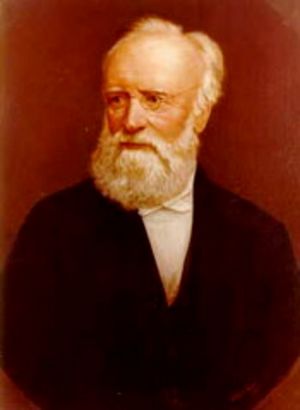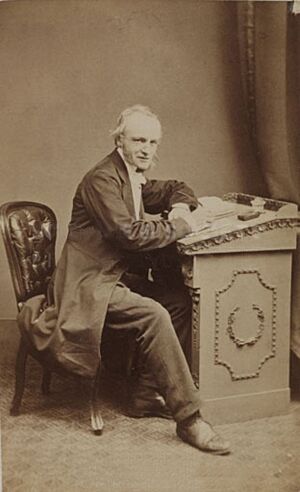William Crawford Williamson facts for kids
Quick facts for kids
William Crawford Williamson
|
|
|---|---|

William Crawford Williamson (1863)
|
|
| Born | 24 November 1816 |
| Died | 23 June 1895 |
| Nationality | English |
| Alma mater | University College, London |
| Occupation | |
William Crawford Williamson (born November 24, 1816 – died June 23, 1895) was an English scientist. He was a naturalist, meaning he studied nature. He was also a palaeobotanist, which means he studied ancient plants, especially their fossils.
Contents
Early Life and Learning
Williamson was born in Scarborough, North Yorkshire. His father, John Williamson, started as a gardener. He became a famous local naturalist. He explored areas along the Yorkshire coast that were rich in fossils. His father was also the first curator of the Scarborough natural history museum, called the Rotunda Museum.
A very important geologist, William Smith, lived with the Williamson family for two years. He is known as the "father of English geology". William's grandfather on his mother's side was a lapidary. This means he was skilled at cutting and polishing stones. Young William learned this art from him.
A Career in Science
Williamson first studied to become a doctor. For three years, he worked as a curator at the Natural History Society's museum in Manchester. He finished his medical studies at University College, London, in 1841. After that, he went back to Manchester to work as a doctor.
In 1851, Owen's College was started in Manchester. Williamson became a professor there. He taught about natural history, which included geology, zoology (the study of animals), and botany (the study of plants). As more professors joined, he focused mainly on botany. He kept his role as a botany professor until 1892.
Williamson also gave many popular talks. He especially lectured for the Gilchrist Educational Trust. He retired in 1892 and moved to Clapham, where he later passed away.
He was chosen to be a Fellow of the Royal Society in 1854. This is a very high honor for scientists. He won their Royal Medal in 1874. He also gave a special lecture called the Bakerian Lecture in 1877.
Important Scientific Discoveries
Williamson started publishing scientific papers when he was just sixteen. In 1834, he wrote about rare birds found in Yorkshire. He also wrote a detailed study on the Gristhorpe Man, an ancient human skeleton. In the same year, he presented his first paper to the Geological Society of London. This paper was about Mesozoic fossils from his home area. He also helped other scientists, Lindley and Hutton, with their book called Fossil Flora of Great Britain.
He did all this important science while also working as a doctor and a professor.
Geology and Ancient Life
In geology, Williamson did early work on how Mesozoic fossils were spread out in different layers of rock. He started this in 1834. In 1845, he studied how tiny living things helped form deposits in the ocean. These were new ideas at the time.
Animals and Plants
In zoology, he studied how the teeth and bones of fish developed between 1842 and 1851. He also studied tiny sea creatures called Foraminifera. He wrote a detailed book about them in 1857 for the Ray Society.
In botany, he studied the tiny structure of a type of algae called Volvox in 1852. His most important work was on the structure of fossil plants. He helped make the study of ancient plants in Britain a true science. Williamson is seen as one of the founders of palaeobotany, along with Adolphe Theodore Brongniart.
Legacy
A type of small crustacean, Bathyporeia guilliamsoniana, was named after him by Charles Spence Bate.


